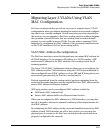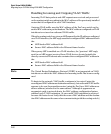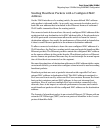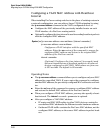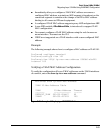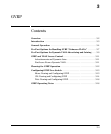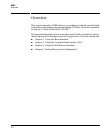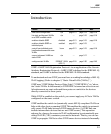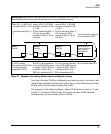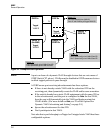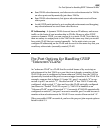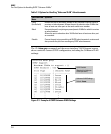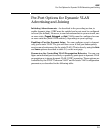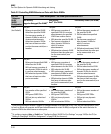
GVRP
Introduction
Introduction
Feature Default Menu CLI Web
view GVRP configuration n/a page 3-13 page 3-14 page 3-18
list static and dynamic VLANs n/a — page 3-16 page 3-18
on a GVRP-enabled switch
enable or disable GVRP disabled page 3-13 page 3-15 page 3-18
enable or disable GVRP on enabled page 3-13 page 3-15 —
individual ports
control how individual ports Learn page 3-13 page 3-15 page 3-18
handle advertisements for new
VLANs
convert a dynamic VLAN to a n/a — page 3-17 —
static VLAN
configure static VLANs DEFAULT_VLAN page 2-24 page 2-30 page 2-45
(VID = 1)
GVRP—GARP VLAN Registration Protocol—is an application of the Generic
Attribute Registration Protocol—GARP. GVRP is defined in the IEEE 802.1Q
standard, and GARP is defined in the IEEE 802.1D-1998 standard.
Note To understand and use GVRP you must have a working knowledge of 802.1Q
VLAN tagging. (Refer to chapter 2, “Static Virtual LANs (VLANs)” .)
GVRP uses “GVRP Bridge Protocol Data Units” (“GVRP BPDUs”) to “adver-
tise” static VLANs. In this manual, a GVRP BPDU is termed an advertisement.
Advertisements are sent outbound from ports on a switch to the devices
directly connected to those ports.
While GVRP is enabled on the switch, you cannot apply any ACLs to VLANs
configured on the same switch.
GVRP enables the switch to dynamically create 802.1Q-compliant VLANs on
links with other devices running GVRP. This enables the switch to automati-
cally create VLAN links between GVRP-aware devices. (A GVRP link can
include intermediate devices that are not GVRP-aware.) This operation
reduces the chances for errors in VLAN configuration by automatically pro-
viding VLAN ID (VID) consistency across the network. That is, you can use
GVRP to propagate VLANs to other GVRP-aware devices instead of manually
3-3



